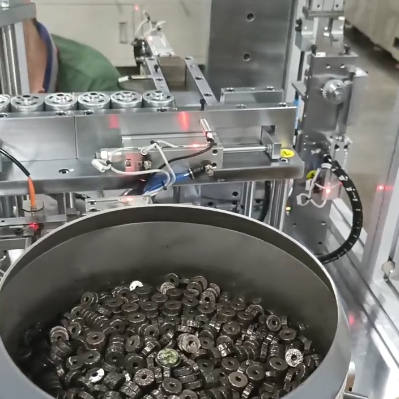DC motor motor automatic bearing press fitting machine what are the common mechanical failures and solutions?
1, transmission components failure
Failure phenomenon:
There is abnormal noise when the equipment is running, such as clicking, buzzing or sharp friction sound.
Transmission components appear loose, jumping or excessive vibration.
Transmission efficiency is reduced, the motor speed is normal but the pressing and loading speed becomes slow or unstable.
Cause analysis:
Wear of transmission parts such as belts, chains or gears. Prolonged use, overloaded operation, poor lubrication or poor material quality may cause wear.
Improper tensioning of transmission parts. Too loose a belt or chain can lead to slippage, while too tight a tension can increase wear and load on the shaft.
Insufficient mounting accuracy of transmission components, such as poor meshing between gears or poor coaxiality of pulleys or sprockets, can cause vibration and noise.
Solution:
Regularly check the wear of transmission parts. For badly worn belts, chains or gears, replace them in time. When replacing, choose parts that are of good quality and meet the specifications of the equipment.
Adjust the tension of the transmission parts. For belt transmission, the proper tension can be achieved by adjusting the tensioning wheel; for chain transmission, there is a special tensioning device or adjusted by adjusting the axis distance. Ensure that the tension is appropriate to ensure transmission efficiency and reduce wear.
Check and adjust the installation accuracy of transmission components. Use professional tools, such as a percentage meter, to check the gear meshing clearance, pulley or sprocket coaxiality, etc., and make precise adjustments according to the installation manual of the equipment.

2、Failure of press-fit parts
Failure phenomenon:
The bearing press-fitting position is inaccurate, with offset, tilt or insufficient depth.
Pressing force is not stable, resulting in poor quality of bearing press fitting, such as insufficient or excessive overload.
Damage to the press-fitting parts (such as press head, mold), surface cracks, deformation or wear.
Cause analysis:
The guiding device of the press-fitting equipment is worn or the precision is reduced, resulting in inaccurate trajectory of the press head.
Problems with the pressure control system, such as malfunctioning pressure sensors, leaks in the hydraulic or pneumatic system, or malfunctioning control valves.
Damage to press-fit components due to long-term high pressure and material fatigue, or hard objects encountered during the press-fit process.
Solution:
Inspect and repair the guides. Clean the guiding device, remove oil and impurities, and check the wear and tear of the guide rails, slides and other parts. If the wear is severe, replace the guide parts with new ones, and make lubrication and accuracy adjustments.
Perform a complete inspection of the pressure control system. For malfunctioning pressure sensors, calibrate or replace them; check the pipelines, joints and seals of the hydraulic or pneumatic system, and repair the leakage points; adjust or replace the regulating valves to ensure stable pressure output.
Replace damaged pressurized components in a timely manner. After replacement, the new parts should be checked for accuracy and debugged to ensure that the quality of press-fitting meets the requirements. At the same time, in the process of press fitting, pay attention to avoid foreign objects into the press fitting area.
3, bearing fixture failure
Failure phenomenon:
The bearing is not firmly fixed in the fixture and is displaced or rotated during the press-fitting process.
The clamping force of the fixture is insufficient or too large, resulting in bearing deformation or damage.
The positioning accuracy of the fixture is poor, affecting the assembly accuracy of the bearing and the shaft or seat hole.
Cause analysis:
Wear and tear of the clamping mechanism of the fixture, such as wear and tear of the jaws, clamping block and other parts, resulting in unstable clamping force.
Design or manufacturing defects of the fixture, such as unreasonable range of adjustment of clamping force, positioning pin wear or lack of precision.
Oil, impurities or damage on the surface of the fixture, affecting the friction and fit between the bearing and the fixture.
Solution:
Inspect and replace worn clamping mechanism parts. Check the jaws, clamping blocks, etc., for wear and tear, and for parts that are badly worn, replace them in time and ensure the quality and dimensional accuracy of the new parts.
Optimize the design and manufacture of fixtures. If the fixture is found to have design or manufacturing defects, improve it according to the actual situation. For example, adjust the range of clamping force adjustment and replace high-precision positioning pins.
Clean and maintain fixtures. Regularly clean the fixture surface of oil and impurities, and check the fixture for damage. For minor damage to the fixture, can be repaired; for serious damage to the fixture, consider remanufacturing or replacement.
4, body and bracket failure
Failure phenomenon:
The equipment body or bracket is deformed, cracked or loose.
The equipment shakes or is unstable during operation, affecting the precision of press fitting.
Cause analysis:
The equipment has been subjected to excessive pressure or vibration for a long time, and the material strength of the fuselage and bracket is insufficient or the structure is not reasonably designed.
The installation foundation of the equipment is not solid, such as loose ground bolts and uneven foundation.
The connection parts of the machine body and bracket are loose, such as loose bolts and cracked welding parts.
Solution:
For deformed or cracked body and bracket, repair or replace them according to the degree of damage. If the damage is light, reinforcement measures can be used, such as welding reinforcement; if the damage is serious, it is necessary to replace the body or bracket with a new one and optimize the structural design.
Check the installation foundation of the equipment and readjust the tightness of the ground bolts to ensure that the equipment is installed on a level and solid foundation. If the foundation is not level, shims can be used for adjustment.
Regularly check the connection parts of the machine body and bracket, and tighten the loose bolts. For the welded parts, check for signs of cracking, and if necessary, make patch welds.
※ If you still can't solve the problem by the above ways and means, please contact the technical specialist of Xinhui Electromechanical Equipment Co., Ltd. through the page chat tool for help.







